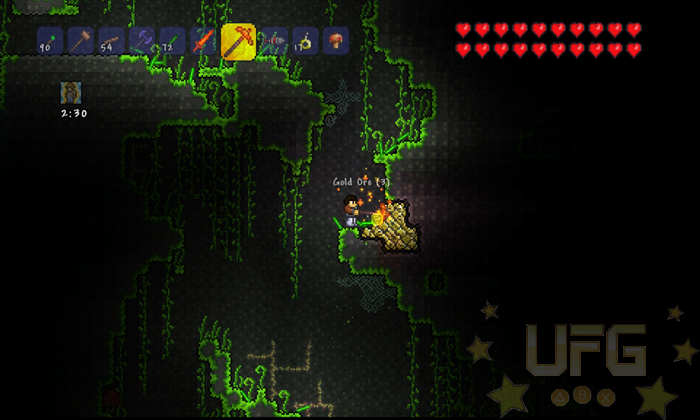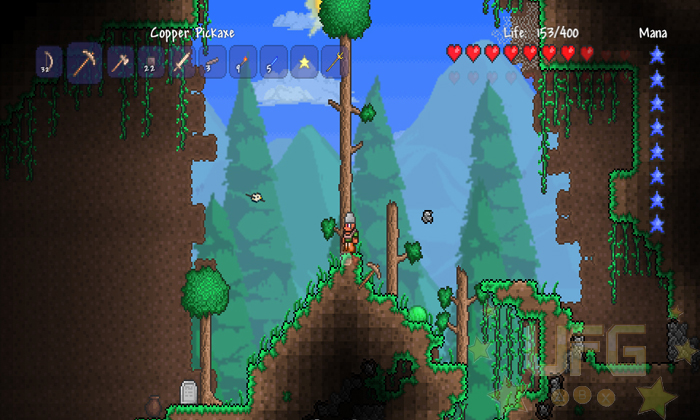Terraria
I’ve never played Minecraft; I read a lot about it and saw videos of people playing it. Yet, while I understand its appeal, I personally wasn’t interested. Terraria was in a similar boat when it was released via Steam back in 2011. Despite the fame it garnered, I made sure to steer clear; it just didn’t seem like my cup of tea. Fast forward to March 28th, 2013…I have a review code in my inbox. After debating if I should review it myself or pass it to another writer, I decide it’s time to see what all the hub bub is about. After hours (and I do mean hours) of game time, I’ve but one conclusion. Terraria is what happens when you mash the concept of Minecraft with something like the Legend of Zelda; pure awesomeness in game form!
For those who aren’t familiar with this genre, Terraria is an adventure game where survival and exploration are its primary selling points. Unlike other adventure games, there are no clear directions, goals, or storyline to follow. Placed in a hostile world with a few basic items, the game forces the player to figure out how to survive on their own. Most of the gameplay elements revolve around gathering resources and using them to craft needed items, fighting off attacking monsters, and building suitable structures to live in. Think Survivor Man but in game form.
That’s the main reason why I wasn’t a fan of the idea behind Minecraft. There was no clear point to the game; even The Sims has short and long term goals. No matter how intrigued I was at the idea of being able to shape an environment to my liking or the challenge of surviving in a foreign world, I always felt like it needed to offer me more. Without giving it a try, I wrote it off. The same thing almost happened to Terraria. Even after playing for an hour or so I felt like I was just searching for a reason to continue on. What I didn’t realize was that I was being conditioned to look at things differently. To allow a purpose to present itself rather than be told what I should be doing. What followed was a pleasant change of pace in my usual gaming experience!
For one, exploration has an actual meaning here. Every world is randomly generated at the start of a new game. While certain elements remain common, specific enemies will spawn in specific places and drop specific items when killed, the environment itself is pieced together to create a unique world for your characters to live in. This means that what you find is based on you efforts alone; finding something of interest is really exciting because the game didn’t tell you it was there. Then there is the fact that the worlds themselves are quite vast. When stating out, the game will allow you to select the size of your world map. They range from small to large or as I like to describe them, big to huge! Each one offers up hours upon hours of exploring foreign locations. You could create a mine shaft that stretches from the top layer of your world to the dark, lava filled areas at the bottom. Or build a tower that reaches up into the heavens in search of a floating island to explore. Not to mention the jungles, dungeons, and all the other areas to wonder through. There is always a lot to discover!
Finding valuable items is also fun due to the game’s crafting system. In order to craft something, you have to be standing by the proper crafting station and have the right ingredients. For example, a forge can be used to melt down ores into blocks which can be then made into swords once taken to an anvil. Each station also needs to be crafted using materials gathered from your exploration; i.e. the forge is made from wood, torches, and stone. The exciting part is that once you’ve collected a crafting material and have the proper station, a new recipe will unlock. Every time I mined a new mineral or cultivated a rare flower, my mind would race at the idea that I might be able to make something I haven’t seen before. Given the fact that the list of items that can be crafted in Terraria is extensive, there is a lot to be excited about. Swords made from meteorite fragments, glowsticks that can light your way underwater, armor made from gold deposits, and potions that turn you invisible are just a few of the many items that can be crafted given the right ingredients.
Another thing that makes Terraria stand out is how the game progresses. Again, there aren’t any objectives that must be completed; there is no winning this game. That said, the game does feature its own set of goals and random occurrences that help give some structure to the game. Along with the normal monsters are boss characters that offer special items and/or unlock new areas to explore once dispatched. Some of them are even tied to the game’s threat level. Beating deadly bosses tells the game that you are ready to face tougher enemies on a regular basis. There is also the ongoing task of acquiring tenants for your town. NPCs that offer a range of goodies for sale can live in rooms of your house once certain conditions are met. One of them even sells a gun that can shoot fallen stars (yes, you read that right). Just when you thought you’ve experienced as much as you can, you hit a milestone and the game offers you more to see and do. Awesome!
Fighting slime monsters, finding rare gems, collecting resources, building homes and secret tunnels, all of these things are fun to do solo. The level of enjoyment shoots through the roof when you have someone to help you explore. My wife and I played via split screen (up to four can play this way), each doing our own thing yet working together. I loved to find new places to explore and new enemies to encounter. My wife on the other hand enjoyed scouring each new location for items that could be used later. The new places I discovered allowed my wife to find new items, which led to us spending the majority of our waking hours in game. I had such a good time that I didn’t even try the online features outside of making sure they functioned. The game allows for up to eight gamers to play in one world at a time, increasing the amount of monsters with each player. PVP can be toggled on and off, items can be traded, so on and so forth. I didn’t care. As far as I was concerned, the split screen co-op play was this amazing cake which just made the online features equivalent to icing!
I had such a great time with my wife that I totally forgot that my early experience with the game was filled with frustration. This brings me to my first of just few complaints. Terraria has a somewhat steep learning curve that may turn off potential fans. Not having the experience of playing on the PC, I was lost on some of the basic gameplay mechanics at first. And while I commend Re-Logic for adding a tutorial to the game, it doesn’t explain things properly. For instance, one of the main things you need to do at the start of the game is build a house. Not only will it offer a safe haven during the night, stronger monsters attack in increased numbers when the sun goes down, but it will also house your first NPC. When I got to that part of the tutorial, I was told to make a house using wood or stone walls. After crafting the walls I began to build my house by placing the walls in the environment. After placing my walls, I needed to place a door. This was logical, as I needed to be able to enter and exit freely. Only I couldn’t place the door against the walls I put down. You see, Terreria is set in a 2D world where “walls” don’t inhabit the foreground. They are placed in the background, because the game reads it as the side of a structure. Which is fine, as a house usually requires four walls to be considered such. The problem is that, only the background positioned sides are actually called “walls”. Everything in the foreground is called something else. Confused yet? I know I was.
After playing around for a bit, I realized that I could craft “blocks”. Blocks, when placed in the world, are placed in the foreground or on the same plane as the player. After successfully making a box using the blocks I was finally able to put the door in. This is when another problem popped up. Even though I was safe at night because of the blocks, the game didn’t recognize my house as a house yet. I later figured out that the blocks needed to be placed on top of the walls; the blocks made up the roof, front and back of the house while the walls made up one of the sides in the background, leaving the other side exposed so you can actually see in the house. Once I had that epiphany, everything just made sense. Most of my time spent figuring out my house issue could have been avoided if the tutorial had expressed the difference between “blocks” and “walls”. I mean, a wall is a wall right?
Another complaint I have is the way the map looks. Pulling up a map of the world helps you to get around pretty well. Except…not always. Let’s say you’ve filled up your inventory and need to return home to drop stuff off, but before you leave you notice a treasure chest. After lightening your load, you pull up the map in hopes of making your way back to the chest. Unfortunately, because of a very limited color pallet you won’t be able to make out where the chest is on the map. It blends in with all the other similarly colored objects. There are ways around this issue but for the most part it’s annoying to deal with.
Other than those minor hindrances, Terraria is one of the best games I’ve played this year. And based on what’s come out so far, that’s no minor feat. Re-Logic’s game doesn’t have dazzling graphics (though I dig the 8-bit look), a long drawn out story, blockbuster action segments, or any first person elements. It does offer a great sense of freedom, old school action and platforming, interesting creation/crafting mechanics, and rewarding gameplay. It’s a game where you get back as much as you put in, which is great even if you only give a little. The start may be a bit rough, but once the wheels start turning, you’ll be hooked. Just like I am. Now if you excuse me, I have a dungeon to explore!
Gameplay:
10
Terraria features a somewhat steep learning curve and takes time to really get into. But once you get into it, it's hard to pull yourself out!
Graphics:
8
The 8-bit graphics are nice; I especially like the little details like the tiny 8-bit embers that fall from torches.
Sound:
8
The soundtrack isn’t too varied. That said, the music isn't bad and new places offer new tunes once discovered.
What's New:
9
I like the way the game progresses when compared to similar titles. Also, this version features new monsters, a final boss, different weapons, and more!
Replay Value:
10
I've spent a stupid amount of time in this game and I haven't even played online yet. There is just so much to find, fight, make, and build that I find it hard to stop playing!
Final Score:
9





